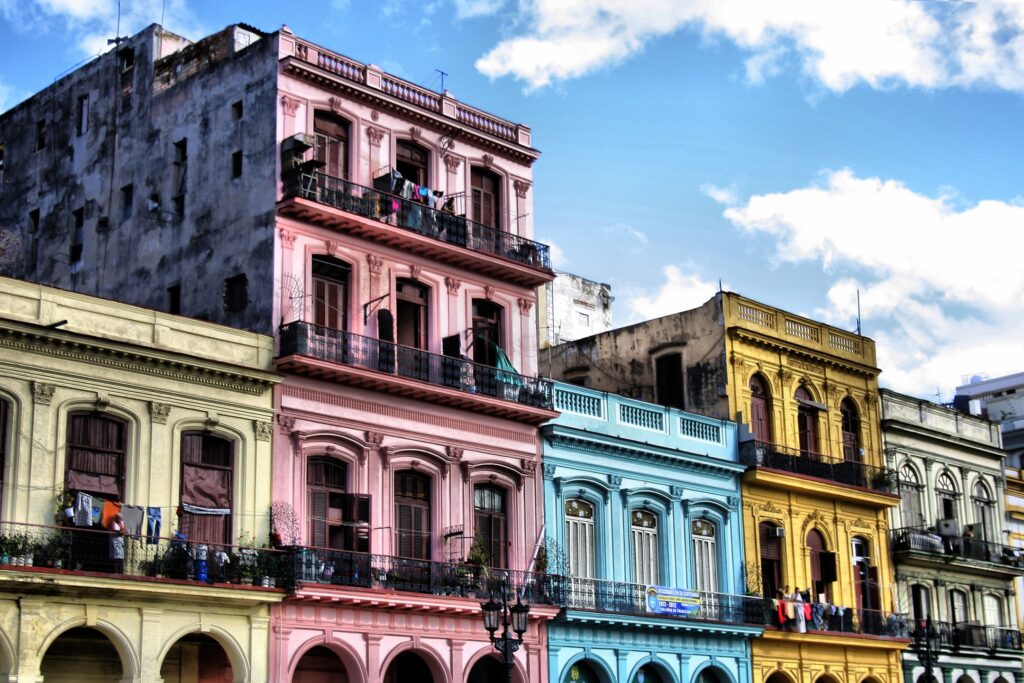Quick facts about Cuba:
- Population: Approximately 11.2 million people.
- Capital: Havana.
- Official Language: Spanish.
- Currency: Cuban peso (CUP)
- Government: Communist state with a single-party system.
- Major Religion: Christianity, predominantly Roman Catholicism.
- Geography: Largest island in the Caribbean, located south of the United States and east of Mexico.
Fact 1: Cuba could be called a museum of old cars
Cuba is famous for its extensive collection of classic American cars from the mid-20th century, affectionately known as “yank tanks” or “almendrones.” These vintage automobiles, predominantly from the 1940s and 1950s, have become iconic symbols of Cuba.
The prevalence of vintage cars in Cuba is a result of various historical factors, including the embargo imposed by the United States in the 1960s, which restricted the importation of new vehicles and led Cubans to maintain and restore existing automobiles. Over the decades, Cubans have ingeniously adapted and preserved these classic cars, often improvising repairs and modifications due to limited access to replacement parts and resources.
Note: If you plan to visit the country, check the need for an International Driver’s License in Cuba to rent and drive a car.

Fact 2: Cuban cigars are known all over the world
Cuba has a long and storied tradition of cigar production, dating back centuries to when indigenous Cuban tobacco was first cultivated by the Taino people. Today, Cuban cigars are considered the pinnacle of cigar craftsmanship and are highly sought after by cigar aficionados around the globe.
The favorable climate and fertile soil of Cuba’s Vuelta Abajo region in the Pinar del Río province are particularly well-suited for growing tobacco, resulting in leaves of exceptional quality and flavor. Cuban cigars are typically made using traditional methods, with skilled torcedores (cigar rollers) hand-rolling each cigar using a combination of filler, binder, and wrapper leaves sourced from premium tobacco plants.
Fact 3: Cuba has 9 UNESCO World Heritage sites
UNESCO World Heritage sites are designated places of cultural or natural significance that are considered to be of outstanding universal value. These sites are selected based on criteria such as historical importance, architectural significance, cultural diversity, or ecological significance.
These sites include:
- Old Havana and its Fortification System: The historic center of Havana, with its well-preserved colonial architecture and fortifications, is a UNESCO World Heritage site.
- Trinidad and the Valley de los Ingenios: The colonial town of Trinidad and the nearby Valley of the Sugar Mills, known for its sugar plantations and historic buildings, are designated as a UNESCO World Heritage site.
- Viñales Valley: Located in the Pinar del Río province, the Viñales Valley is renowned for its unique karst landscapes, traditional agriculture, and tobacco farming methods.
- Desembarco del Granma National Park: This coastal national park in southeastern Cuba features dramatic cliffs, caves, and marine terraces, as well as fossilized dinosaur footprints.
- Alejandro de Humboldt National Park: Located in eastern Cuba, this UNESCO World Heritage site is known for its exceptional biodiversity, including endemic species and diverse ecosystems.
- San Pedro de la Roca Castle, Santiago de Cuba: Also known as El Morro Castle, this historic fortress overlooks the entrance to Santiago Bay and played a crucial role in protecting the city from pirate attacks.
- Historic Center of Camagüey: The colonial town of Camagüey, with its maze-like street layout and well-preserved architecture, is recognized as a UNESCO World Heritage site.
- Urban Historic Center of Cienfuegos: The city of Cienfuegos, founded by French settlers in the 19th century, boasts elegant neoclassical architecture and a well-designed urban layout.
- Archaeological Landscape of the First Coffee Plantations in the Southeast of Cuba: This UNESCO World Heritage site comprises a series of historic coffee plantations and cultural landscapes dating back to the 19th century.

Fact 4: Cuba had two currencies
Cuba’s dual currency system has existed since the 1990s and was originally introduced as a response to the economic problems that arose after the collapse of the Soviet Union. The Cuban Convertible Peso (CUC) was created as a currency pegged to the U.S. dollar and used mainly for transactions involving foreign tourists, imported goods and some services.
Cuba’s current currency is the Cuban peso, however it is pegged to the dollar and has a public and unofficial exchange rate. Some stores may accept US dollars for payment.
Fact 5: Cuba is the largest island in the Caribbean
Cuba is the largest island in the Caribbean, with a land area of approximately 109,884 square kilometers (42,426 square miles). It is located in the northern Caribbean Sea, south of the United States and east of Mexico. Cuba’s territorial waters are home to a diverse array of smaller islands, islets, and cays, although the exact count can vary depending on the criteria used to define an island
Among the notable smaller islands and archipelagos within Cuban territory are the Isla de la Juventud (Isle of Youth), Cayo Coco, Cayo Largo del Sur, the Jardines del Rey (Gardens of the King) archipelago, and the Sabana-Camagüey Archipelago.

Fact 6: Cuba has a rich biodiversity
Cuba is known for its high levels of endemism, with many species found nowhere else in the world. This includes endemic plants such as palms, orchids, and ferns, as well as animals like the Cuban crocodile, Cuban solenodon, and the world’s smallest bird, the bee hummingbird.
The country’s marine ecosystems, including coral reefs, seagrass beds, and mangrove forests, are also home to a rich variety of marine life, including colorful fish, crustaceans, and marine mammals.
Fact 7: Cuba has a lot of preserved colonial architecture
Cuba’s colonial architecture is a testament to its centuries-long history of Spanish colonial rule and influence. The island’s cities and towns feature a wealth of architectural styles, ranging from Spanish Baroque and Neoclassical to Art Deco and eclectic combinations of various influences.
Havana, the capital city, boasts a particularly impressive collection of colonial-era buildings, including grand cathedrals, stately palaces, and elegant mansions. The historic center of Old Havana (Habana Vieja) is a UNESCO World Heritage site and is renowned for its cobblestone streets, colorful buildings, and architectural landmarks such as the Cathedral of Havana, the Plaza de Armas, and the Castillo de la Real Fuerza.
Beyond Havana, other Cuban cities such as Trinidad, Cienfuegos, Camagüey, and Santiago de Cuba also feature significant examples of colonial architecture. These cities have well-preserved historic districts characterized by charming plazas, ornate facades, and centuries-old buildings that offer visitors a glimpse into Cuba’s colonial past.

Fact 8: The Cuban crisis almost led to nuclear war
The Cuban Missile Crisis of October 1962 was a perilous moment in Cold War history. It began when the US discovered Soviet missiles in Cuba, triggering a tense standoff. President Kennedy imposed a naval blockade, while Khrushchev sought a cautious resolution. After thirteen days of brinkmanship, a peaceful agreement was reached. The Soviets removed the missiles from Cuba, and the US pledged to remove missiles from Turkey. Though it avoided nuclear war, the crisis highlighted the need for diplomatic solutions amid global tensions.
Fact 9: Cuba has an interesting New Year’s tradition
In Cuba, New Year’s Eve, known as “Nochevieja,” is celebrated with a blend of traditional customs, family gatherings, and festive revelry. One of the most distinctive New Year’s traditions in Cuba is the tradition of “Las doce uvas de la suerte” or “The twelve lucky grapes.”
As midnight approaches, it is customary for Cubans to gather with family and friends, often in homes or public squares, to welcome the New Year. Just before midnight, everyone prepares twelve grapes, one for each stroke of the clock at midnight. As the clock chimes twelve times, each grape is eaten, with each grape symbolizing good luck for each month of the upcoming year.
In addition to the grape-eating tradition, New Year’s celebrations in Cuba often include music, dancing, fireworks, and feasting. Many people attend parties, concerts, or cultural events to ring in the New Year with joy and enthusiasm.

Fact 10: Cuba is home to a variety of alcoholic beverages
Cuba has a rich tradition of alcohol production, with several beverages being closely associated with Cuban culture and heritage. Some of the most well-known Cuban alcoholic beverages include:
- Rum: Cuba is famous for its rum, which is made from sugarcane molasses or sugarcane juice. Cuban rum is known for its smooth flavor and is used in many classic cocktails, including the Mojito, Daiquiri, and Cuba Libre. Popular Cuban rum brands include Havana Club, Santiago de Cuba, and Ron Varadero.
- Cuba Libre: Also known as a “rum and coke,” the Cuba Libre is a simple cocktail made with Cuban rum, cola, and lime juice. It is a popular drink both in Cuba and around the world.
- Piña Colada: While the exact origins of the Piña Colada are debated, Cuba is often credited as one of the birthplaces of this tropical cocktail. It typically consists of rum, coconut cream or milk, and pineapple juice, blended with ice and served garnished with a pineapple wedge and cherry.
- Cristal and Bucanero: These are two popular Cuban beer brands. Cristal is a light lager, while Bucanero is a stronger and darker beer.
- Guarapo: Guarapo is a traditional Cuban beverage made from freshly squeezed sugarcane juice. It is often served cold and is a refreshing and popular drink, especially during hot weather.

Published April 14, 2024 • 8m to read





